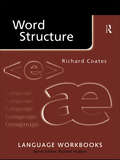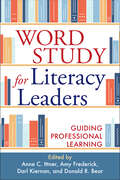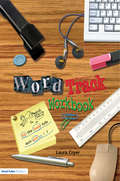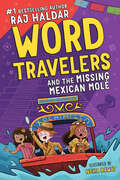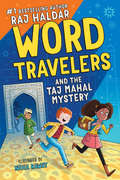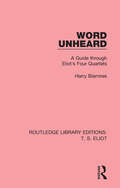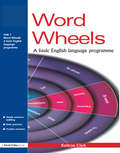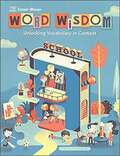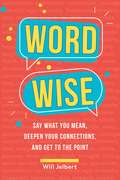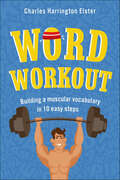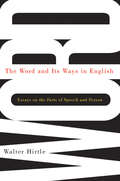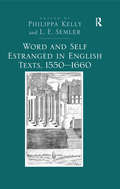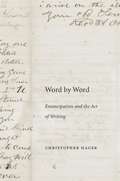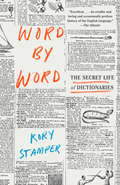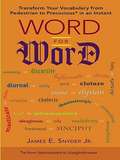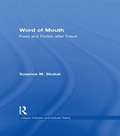- Table View
- List View
Word Structure (Language Workbooks)
by Richard CoatesWord Structure, provides a complete introduction to morphology, the study of the structure of words. Word Structure:* examines how words work as part of the language system* encourages readers to take an objective and analytic approach* refers to a wealth of languages, including Turkish and Latin, to illustrate points raised* provides clear and succinct summaries at the end of each unit.
Word Study for Literacy Leaders: Guiding Professional Learning
by Donald R. Bear Amy Frederick Darl KiernanWritten and edited by experts in the field, this book provides a blueprint for weaving effective word study into the fabric of classrooms and schools. Provided are principles, ideas, materials, and activities for use with teachers in a range of professional learning contexts. Key topics include word study foundations and orthographic knowledge; implementing collaborative coaching models, "learning huddles," and workshops; and word study strategies for young children, emergent bilingual students, and adolescents. Helpful reproducible tools include the empirically validated Word Study Classroom Observation Guide. Purchasers get access to a companion website where they can download and print the reproducible materials in a convenient 8 1/2" x 11" size.
Word Track Workbook
by Laura CryerFirst Published in 2004. Routledge is an imprint of Taylor & Francis, an informa company.
Word Travelers and the Missing Mexican Molé (Word Travelers)
by Raj HaldarAre you ready for adventure? The second book in a new action-packed series from bestselling author Raj Haldar follows two best friends as they race to different parts of the world to solve mysteries and uncover lost treasures!It's finally time for the party! Every year, best friends Edie and Molly-Jean (who still prefers to be called MJ) throw a costume party and have the best time. They plan the perfect outfits, order pizza, and dance to silly songs…but this year they'll also magically travel to Mexico and find themselves in the middle of Día de los Muertos celebrations to discover that a secret mole recipe has been stolen!This action-packed mystery story is perfect for anyone looking for:A wild adventure around the world that middle school kids will love!A story of two best friends solving mysteries with magic!Cool, new knowledge tucked inside an epic chapter book!A journey to Mexico to learn the Spanish roots of the English languageMagically travel around the world along with two best friends who decipher clues and uncover mysterious secrets. Can you help them find the golden key?
Word Travelers and the Taj Mahal Mystery (Word Travelers)
by Raj HaldarAre you ready for adventure? The first book in a new action-packed series from bestselling author Raj Haldar follows two best friends as they race to different parts of the world to solve mysteries and uncover lost treasures!It's a Super Saturday sleepover! That means best friends Eddie and Molly-Jean (who prefers to be called MJ) are going to play outside, create obstacle courses for MJ's newts, and watch their favorite movies—and then they'll travel to India to solve a mystery and help save a school—all before bedtime!This action-packed mystery story is perfect for anyone looking for:A wild adventure around the world that middle school kids will love!A story of two best friends solving mysteries with a little magic!Cool, new knowledge tucked inside an epic chapter book!A journey to India to learn the Hindi roots of the English languageMagically travel around the world along with two best friends who decipher clues and uncover mysterious secrets. Can you help them find the golden key?"Reminiscent of Mary Pope Osborne's "Magic Tree House" series…contains the same mix of fantasy, adventure, and cultural discovery. Etymology is the distinctive feature here, and its importance is reflected in every part of the text."—School Library Journal, starred review
Word Unheard: A Guide Through Eliot's Four Quartets
by Harry BlamiresEliot’s Four Quartets is arguably the finest long poem in modern English literature. It is also one that presents considerable problems of interpretation. In Word Unheard, first published in 1969, Blamires aims to unravel some of these problems by guiding the reader line by line through the poem, blending paraphrase with commentary. Blamires pays particular attention to the philosophical and theological dimensions of the poem and to its multifarious personal, historical and literary allusions. This title will be of interests to students of literature.
Word Wealth
by Ward MillerThis textbook offers insights into words and their meanings in straightforward, simple and plain way.
Word Wheels
by Kathryn ClarkTargeting the specific problems learners have with language structure, these multi-sensory exercises appeal to all age groups including adults. Exercises use sight, sound and touch and are also suitable for English as an Additional Lanaguage and Basic Skills students. Word Wheels includes off-the-shelf resources including lesson plans and photocopiable worksheets, an interactive CD with practice exercises, and support material for the busy teacher or non-specialist staff, as well as homework activities.
Word Wisdom Unlocking Vocabulary in Context Grade 3
by Zaner-BloserZaner-Bloser Word Wisdom Grade 3 Student Edition
Word Wisdom Unlocking Vocabulary in Context, Grade 6
by Jerry ZutellWord Wisdom Unlocking Vocabulary in Context
Word Wisdom: Vocabulary for Listening, Speaking, Reading and Writing, Level D
by Jerry ZutellNIMAC-sourced textbook
Word Wisdom: Vocabulary for Listening, Speaking, Reading and Writing, Level G
by Jerry ZutellNIMAC-sourced textbook
Word Wise: Say What You Mean, Deepen Your Connections, and Get to the Point
by Will JelbertSupercharge your speech to get what you want out of every conversation with this fun and practical guide to verbal vividness.An eye-opening guide on how we talk and write to one another, Word Wise explores 400+ of the most common cases of word trash (filler words, hyperbole, and abstractions) and word power (verbs of action, ear candy, onomatopoeia). Examining social media, the language of Donald Trump, AI language research, and heard-on-the-street lingo, communication expert Will Jelbert offers simple and concrete recommendations for improving your own vernacular.With wit, practical applications, and a small dose of grammar, Word Wise will help you communicate more effectively at home, at work, and online.
Word Workout: Building a Muscular Vocabulary in 10 Easy Steps
by Charles Harrington ElsterWord Workout is a practical book for building vocabulary—a graduated program featuring thousands of words that begins with those known by most college graduates and ascends to words known only by the most educated, intelligent, and well-read adults. This workout is a comprehensive program, chock-full of information about synonyms, antonyms, and word origins, and replete with advice on proper usage and pronunciation. There are also creative review quizzes at each step of the way to measure your progress and reinforce learning. Unlike other vocabulary books, Word Workout provides a complete learning experience with clear explanations and surefire methods to retain new knowledge. Far more than a cram session for a standardized test, this book is designed as a lifetime vocabulary builder, featuring words used by the top tier of literate Americans, laid out in ten accessible chapters designed for anyone who is looking for some serious verbal exercise.From "avowal" to "proselytize," from "demagogue" to "mendicant," Charles Harrington Elster has carefully picked the words you need to know, and given you an easy, fast, and fail-safe way to learn and remember them.
Word and Image in Arthurian Literature (Routledge Library Editions: Arthurian Literature)
by Keith BusbyOriginally published in 1996, the articles in this book are revised, expanded papers from a session at the 17th International Congress of the Arthurian Society held in 1993. The chapters cover Arthurian studies’ directions at the time, showcasing analysis of varied aspects of visual representation and relation to literary themes. Close attention to the historical context is a key feature of this work, investigating the linkage between texts and images in the Middle Ages and beyond.
Word and Image: Invitations to a Culture of Composition
by Jeff Wiemelt Natasha Whitton Jayetta SlawsonWord and Image: Invitations to a Culture of Composition is designed to be used in a variety of classrooms for courses in developmental writing, introductory composition, and research writing. A number of very useful tools and features are available for students and teachers using this book.
Word and Its Ways in English: Essays on the Parts of Speech and Person
by Walter HirtleWords are the foundation, the building blocks of language. While an obvious and irreplaceable concept in the minds of non-linguists, the entry "word" does not figure in the indexes of some books on linguistics. Why is there this neglect of the word among many contemporary linguists? Inspired by the work of the French linguist Gustave Guillaume and the last in a series of books, The Word and Its Ways in English is a study of the way the word is configured in English, and an attempt to discern its nature. Walter Hirtle presents the word as the smallest element of meaning in the brain. He also explores how thoughts in the mind of a speaker become a succession of spoken words that are translated back into meaning in the mind of a listener. He examines different categories of words and how grammatical components such as person, case, and gender contribute to a word’s meaning and are intimately linked to the mind. A thought-provoking account of the workings of grammar and the semantic notions that underlie grammatical distinctions, The Word and Its Ways in English is essential reading for anyone seeking a deeper understanding of the link between language, meaning, and words.
Word and Self Estranged in English Texts, 1550–1660
by L.E. SemlerThe essays in Word and Self Estranged in English Texts, 1550-1660, consider diverse historical contexts for writing about 'strangeness'. They draw on current practices of reading to present contrasts and analogies within and between various social understandings. In so doing they reveal an interplay of thematic and stylistic modes that tells us a great deal about how, and why, certain aspects of life and thinking were 'estranged' in sixteenth and seventeenth century thinking. The collection's unique strength is that it makes specific bridges between contemporary perspectives and early modern connotations of strangeness and inhibition. The subjects of these essays are 'strange' to our ways of thinking because of their obvious distance from us in time and culture. And yet, curiously, far from being entirely alien to these texts, some of the most modern thinking-about paradigms, texts, concepts-connects with the early modern in unexpected ways. Milton meets the contemporary 'competent reader', Wittgenstein meets Robert Cawdrey, Shakespeare embraces the teenager, and Marvell matches wits with French mathematician René Thom. Additionally, the early modern texts posit their own 'others', or sites of estrangement-Moorishness, Persian art, even the human body-with which they perform their own astonishing maneuvers of estrangement and alignment. In reading Renaissance works from our own time and inviting them to reflect upon our own time, Word and Self Estranged in English Texts, 1550-1660 offers a vital reinterpretation of early modern texts.
Word by Word
by Christopher HagerOne of the cruelest abuses of slavery in America was that slaves were forbidden to read and write. Consigned to illiteracy, they left no records of their thoughts and feelings apart from the few exceptional narratives of Frederick Douglass and others who escaped to the North-or so we have long believed. But as Christopher Hager reveals, a few enslaved African Americans managed to become literate in spite of all prohibitions, and during the halting years of emancipation, thousands more seized the chance to learn. The letters and diaries of these novice writers, unpolished and hesitant yet rich with voice, show ordinary black men and women across the South using pen and paper to make sense of their experiences. Through an unprecedented gathering of these forgotten writings-from letters by individuals sold away from their families, to petitions from freedmen in the army to their new leaders, to a New Orleans man’s transcription of the Constitution-Word by Word rewrites the history of emancipation. The idiosyncrasies of these untutored authors, Hager argues, reveal the enormous difficulty of straddling the border between slave and free. These unusual texts, composed by people with a unique perspective on the written word, force us to rethink the relationship between literacy and freedom. For African Americans at the end of slavery, learning to write could be liberating and empowering, but putting their hard-won skill to use often proved arduous and daunting-a portent of the tenuousness of the freedom to come.
Word by Word: The Secret Life of Dictionaries
by Kory StamperDo you have strong feelings about the word “irregardless”? Have you ever tried to define the word “is”? Brimming with intelligence and personality, this vastly entertaining account of how dictionaries are made is a must-read for word mavens. Many of us take dictionaries for granted, and few may realize that the process of writing dictionaries is, in fact, as lively and dynamic as language itself. With sharp wit and irreverence, Kory Stamper cracks open the complex, obsessive world of lexicography, from the agonizing decisions about what to define and how to do it, to the knotty questions of usage in an ever-changing language. She explains why small words are the most difficult to define, how it can take nine months to define a single word, and how our biases about language and pronunciation can have tremendous social influence. And along the way, she reveals little-known surprises—for example, the fact that “OMG” was first used in a letter to Winston Churchill in 1917. Word by Word brings to life the hallowed halls (and highly idiosyncratic cubicles) of Merriam-Webster, a startlingly rich world inhabited by quirky and erudite individuals who quietly shape the way we communicate. Certain to be a delight for all lovers of words, Stamper’s debut will make you laugh as much as it makes you appreciate the wonderful complexities and eccentricities of the English language.
Word for Word
by James E. Snyder JDAn ingeniously handy guide to help you transform chew into masticate, rainy into pluvian?or antediluvian into plain old old.Attorney James Snyder didn?t set out to write a book about words. But one day he looked up the word animadversion. The definition said it means the same thing as aspersion. He wasn?t quite sure what that meant, so he looked it up. It meant the same thing as slander. At last he was getting somewhere? and he stumbled upon an inconvenient truth about dictionaries: If you don?t know big words, they sometimes aren?t much help. So Snyder started collecting what he calls one-word definitions?simple words for fancy ones, and fancy words for simple ones. So whether you?re a penster (writer) looking for the right palabra (word), or just a solecistic (ungrammatical) malingerer (faker) trying to gasconade (show off ) to your gormless (stupid) yokemates (co-workers), this handy and engaging reference presents the right word for any occasion.
Word from the Mother: Language and African Americans
by Geneva SmithermanWritten by the hugely respected linguist, Geneva Smitherman, this book presents a definitive statement on African American English. Enriched by her evocative and inimitable prose style, the study presents an overview of past debates on the speech of African Americans, as well as providing a vision for the future. Featuring cartoons which demonstrate the relationship between language and race, as well as common perceptions of African American Language, she explores its contribution to mainstream American English and includes a summary of expressions as a suggested linguistic core of AAL. As global manifestations of Black Language increase, she argues that, through education, we must broaden our conception of AAL and its speakers, and further examine the implications of gender, age and class on AAL. Perhaps most of all we must appreciate the ‘artistic and linguistic genius’ of AAL, presented in this book through rap and Hip Hop lyrics and the explorations of rhyme and rhetoric in the Black speech community. Word from the Mother is an essential read for students of African American English, language, culture and sociolinguistics, as well as the general reader interested in the worldwide ‘crossover’ of black popular culture.
Word from the Mother: Language and African Americans (Routledge Linguistics Classics)
by Geneva SmithermanThis classic text by Geneva Smitherman, pioneering scholar of Black Talk, is a definitive statement on African American Language (AAL). Enriched by her inimitable writing style, the book outlines past debates on the speech of African Americans and provides a vision for the future. As global manifestations of AAL increase, she argues that we must broaden our conception of the language and its speakers, and further examine the implications of gender, age and class on AAL. Perhaps most of all we must appreciate the "artistic and linguistic genius" of AAL, from Hip Hop lyrics to the rhyme and rhetoric of the broader Black speech community. Smitherman explores AAL's contribution to American English, includes a summary of expressions as a suggested linguistic core of AAL, and features cartoons that educate readers on the broader relationship between language, race, and racism. This classic edition features a new foreword by H. Samy Alim, celebrating Smitherman's continuing impact on Black Language scholarship and her influence on the future of the field. Word from the Mother is an essential read for students of African American speech, language, culture and sociolinguistics, as well as the general reader interested in the worldwide "crossover" of Black popular culture.
Word of Mouth: Food and Fiction After Freud (Literary Criticism and Cultural Theory)
by Susanne M. SkubalFirst Published in 2002. Routledge is an imprint of Taylor & Francis, an informa company.
